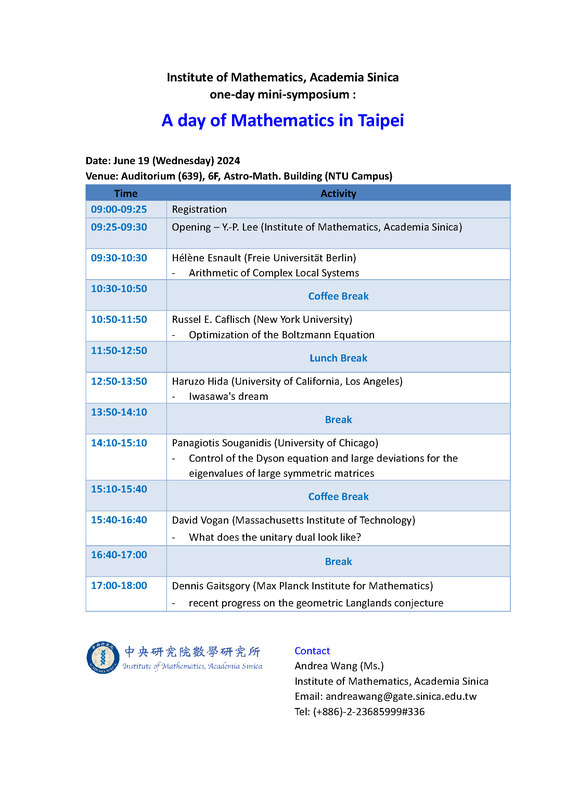
A day of Mathematics in Taipei
Date: June 19 (Wednesday) 2024
Venue: Auditorium (639), 6F, Astro-Math. Building (NTU Campus)
Hélène Esnault
Title: Arithmetic of Complex Local Systems
Abstract:
We’ll survey some of the results and methods we developed with Michael Groechenig in the last years. For example, using the existence of companions (L. Lafforgue and Drinfeld) in the sense of Deligne, stemming from the arithmetic Langlands program, we could prove the integrality of complex cohomologically rigid local systems (a conjecture of Simpson), or, using in addition de Jong’s conjecture on the existence of ℓ-adic local systems on varieties over a finite field (conjecture proved by Gaitsgory in all generality using the geometric Langlands program), we could produce (with de Jong) a new obstruction for a finitely presented group to be the topological fundamental group of a complex quasi-projective manifold
Russel E. Caflisch
Title: Optimization of the Boltzmann Equation
Abstract:
The kinetics of rarefied gases and plasmas are described by the Boltzmann equation and numerically approximated by the Direct Simulation Monte Carlo (DSMC) method. We present an optimization method for DSMC, derived from an augmented Lagrangian. After a forward (in time) solution of DSMC, adjoint variables are found by a backwards solver. They are equal to velocity derivatives of an objective function, which can then be optimized. This is joint work with Yunan Yang (Cornell) and Denis Silantyev (U Colorado, Colorado Springs).
Haruzo Hida
Title: Iwasawa's dream
Abstract:
We discuss Conjectures/Problems (in cyclotomic theory) Iwasawa described in one of his final unpublished manuscripts [U3]. Then if time allows, we indicate which of his problems has generalizations in more general settings of non-abelian Galois representations via the theory of modular forms. In the general case, the Iwasawa algebra is replaced by a universal deformation ring (which is a p-adic Hecke algebra by a theorem of Taylor-Wiles). We encounter new interesting problems related to Iwasawa's question in the general cases.
Panagiotis Souganidis
Title: Control of the Dyson equation and large deviations for the eigenvalues of large symmetric matrices
Abstract:
The control of the Dyson equation, which is the mean field equation for the eigenvalues of random symmetric matrices, leads to the study of a nonlinear Hamilton-Jacobi-type equation with singularities in the set of probability spaces. In the lecture, I will describe how to establish the well-posedness of the solutions of these equations. Then, I will use these results to obtain large deviations for the eigenvalue of large symmetric matrices and analyze the so-called Iztyson and Zuber formula in mathematical physics. This is part of a joint work with Charles Bertucci and Pierre-Louis Lions.
David Vogan
Title: What does the unitary dual look like?
Abstract:
Gelfand in the 1930s introduced the problem of finding the "unitary dual" of any locally compact group G. I'll talk about this problem in case G is a reductive Lie group. The first big idea is that limiting processes on G lead to "parabolic subgroups," whose (very simple) description was worked out by Chevalley and others in the 1950s.
The second big idea is to follow unitary representations through the limiting process, and so relate them to unitary representations on smaller groups. This was worked out by Harish-Chandra, Zuckerman, and others in the 1960s and 1970s.
Finally one arrives at a rather small collection of "unipotent representations" for which no limiting degeneration is available. The big ideas for understanding this set come from work of Lusztig, Arthur, Barbasch, and others beginning in the 1980s. I'll try to say a little about our (still incomplete) understanding of these.
Dennis Gaitsgory
Title: recent progress on the geometric Langlands conjecture
Abstract:
In the talk I’ll review the statement of the geometric Langlands conjecture in its various forms and explain the new ideas that led to its proof. This is a joint project with Arinkin, Beraldo, Campbell, Chen, Faergeman, Lin, Raskin and Rozenblyum.


